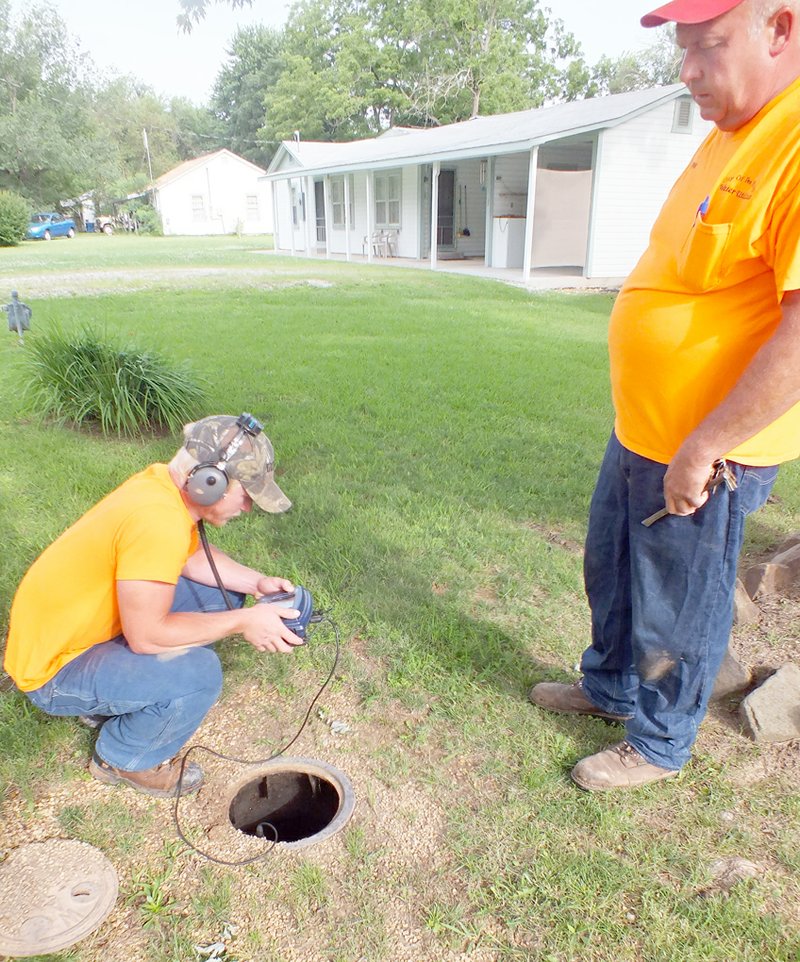Honing their listening skills, Pea Ridge Water Department employees Curtis Wiltgen, Ronnie Hicks and Jake Wagner are saving the city money.
Listening to the ground, the locate, then repair water leaks.
"They're really good at what they do," Ken Hayes, superintendent of the Pea Ridge Water/Wastewater Dept., said of his employees. "We have been super busy; we're starting to catch up.
"Whenever they aren't working on something else, they're looking for leaks."
Hayes said the water loss for the city department is down to 8.1 percent from 40 percent nearly 10 years ago.
"The water loss numbers were extremely good for the last fiscal year," Hayes said. "That's lower than we've ever been able to get it. That's lower than anyone I know of in northwest Arkansas."
"We've got some guys that area really good at it," he said, explaining that most of them learned from "the school of hard knocks." He said when the most recent piece of equipment was purchased, the company sent someone to train the employees, but his guys already knew how to listen for leaks. They basically learned more about how to fine tune the equipment.
While one man works wearing ear phones, another stands by for safety because the man wearing the ear phones can not hear someone driving close to him. Sounds can come from electrical or gas lines nearby and the men have learned to distinguish the source of the sound.
"They're relentless," Michael Nida, field supervisor and inspector, said of the employees who have increased their ability to detect leaks. "If one hears something, he'll ask the other to double check. They're constantly bouncing off one another improving their skills."
"When they hear something, it is not always a leak. When they hear a leak, they put a paint dot on the ground. Most of the time, it's right there. The equipment is pretty sophisticated," Hayes said. "For a small town, we've got pretty sophisticated equipment."
When a leak is found, the crews mark the spot. Later, the men will dig it up and repair the leak.
"Finding it is the hard part. Fixing it is the easy part," Hayes said. In addition to repairing the water line, Pea Ridge Water Department employees rebuilt the driveway aprons or roadway. The men know how to work concrete and lay asphalt, Hayes said, saving the city even more money than if they contracted those jobs out.
Because of the rocky terrain in northwest Arkansas, Hayes said water leaks are common. Pea Ridge Water provides water to Brush Creek where the water loss is much higher because of the age of the lines and the terrain.
"In Brush Creek it was 41 percent," Hayes said. "Brush Creek is killing us."
"When all that was put in," he said, "they didn't sleeve under the roads."
A certain amount of water loss is to be expected, Hayes explained, adding that water lines are not glued together. "They have to move. They have seals."
He said temperature fluctuations and the earth moving cause lines to move. A line on a rock, will fracture over time as it moves over the rock.
"The winter was very cold. Right now, we're still looking for leaks. We've found most of them. We had temperatures below freezing for weeks at a time three different times," Hayes said. He explained that in most of the city, the ground is Cherokee silt loam. When a leak occurs in that type of ground, the water will rise. But, some other areas, like off South Curtis Avenue and Halleck Lane, the ground is so rocky that the water leaking goes down and is more difficult to detect visually.
Another factor in water loss is that Two Ton is now using a 1,000-horsepower pump increasing the water pressure. Water at Brush Creek is direct feed, it doesn't go through a tower first like it does in town. "If they're pressure goes from 100 psi to 150 psi, it will cause a leak in those old lines," Hayes said.
Now, the department is in the process of putting in PVC pipes every 300 feet from Brush Creek master meter to Beard's pit in Sugar Creek Valley off Arkansas Highway 94. That line is so old, Hayes said, that it is difficult to get a listening device on it. The pipes will provide a way to listen for leaks and, with numbers correlated, the exact location of the leak can be determined.
The city buys the water from Two Ton, then sells it to customers. Hayes said some water departments will differentiate between water loss through lines and water loss from flushing lines and use by the Fire Department. He doesn't. Basically, if the city buys it, it flows out but is not purchased, he counts it as water loss.
"If we don't sell it, it needs to be counted," Hayes said.
In addition to locating and repairing leaks, the men will be testing the water flow on fire hydrants, Hayes said.
For about five years, the Fire Department tested the flow on fire hydrants, but the Water Department will perform those tests now. There are about 275 fire hydrants in the city.
"It will take about a month," Nida said. "We started flow testing on fire hydrants yesterday."
General News on 07/02/2014

